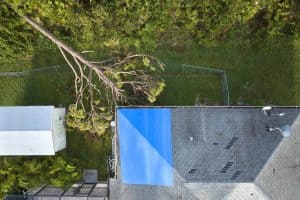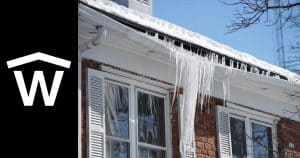In Calgary’s dynamic climate, where temperatures swing dramatically, the silent issue of condensation in your home demands attention. This often unseen problem can escalate quickly, turning from simple moisture to ice, and potentially wreaking havoc on your roof. Let’s take a deep dive into the nature of condensation, its heightened impact in our region, and discover effective ways to prevent and manage it.
Understanding Condensation in Calgary’s Climate
Condensation might seem like a minor issue, but in Calgary, where temperature changes are a common occurrence, its effects can be far more severe. This was particularly evident in the record deep freeze the city experienced in early January 2024. When moist air inside your home meets colder surfaces, especially during such freezing cold spells, it can lead to water or even ice formation. This phenomenon is especially problematic in areas like attics and bathrooms, where inadequate ventilation can worsen the situation.
Given our city’s unique climate conditions, it’s crucial to understand how these temperature variations can lead to significant roofing challenges. We’re not just talking about usual moisture concerns; in Calgary, condensation can lead to more serious issues like attic rain and moisture damage within your attic. Some minor condensation and ice formation is normal, but when temperature changes can break old windows, imagine what it can do to other parts of your home, like your attic and roof.
This video serves as a vivid illustration of the impact of condensation. Witness how excessive moisture and ice formation, exacerbated by Calgary’s recent deep freeze, led to cracking old windows. This visible damage is a telltale sign of what could be happening in less visible areas of your home, particularly in your attic. If this is what we can see, consider the potential unseen damage in areas you rarely check.
The Dangers of Excessive Condensation
Excessive condensation in your home, particularly following extreme weather conditions like Calgary’s deep freezes, can lead to several serious issues:

- Structural Damage: Excessive moisture can weaken the structural components of your home, including your roof, such as rafters and joists. Over time, this can lead to sagging or even collapse, especially if compounded by the weight of snow or ice.
- Mould and Mildew Growth: Damp conditions created by condensation are ideal for the growth of mould and mildew. These not only damage the surfaces they grow on but can also pose significant health risks, particularly to those with allergies or respiratory conditions.
- Ice Damming: A specific concern in colder climates like Calgary, ice dams form when heat from the attic melts snow on the roof, which then refreezes at the eaves. This can cause water to back up under the shingles, leading to leaks and water damage.
- Attic Rain: This occurs when accumulated condensation suddenly releases, creating a rain-like effect inside the attic. This phenomenon can lead to unexpected water damage, particularly in areas that are not regularly inspected.
- Increased Energy Costs: Poor insulation and ventilation can lead to higher heating costs. Moisture-laden air is more difficult to heat, and over time, condensation can degrade the effectiveness of your insulation.
Understanding these risks is only the first step. Identifying early signs of condensation problems and taking proactive measures are crucial for protecting your home.
Identifying Early Signs of Condensation Problems
Early detection of condensation issues is key to preventing serious damage. Homeowners should be aware of these telltale signs:

- Improve Ventilation: Ensure good airflow with exhaust fans in high-moisture areas like bathrooms and kitchens. Consider additional ventilation systems for attics and basements.
- Enhance Insulation: Proper insulation keeps temperatures stable and reduces condensation risk. Check insulation in walls, roofs, and around windows and doors.
- Use Dehumidifiers: In areas of high humidity, a dehumidifier can help control moisture. It’s especially useful in basements or during periods of heavy rainfall.
- Seal Gaps and Cracks: To prevent warm air from seeping into cooler areas, seal gaps around windows, doors, and where utilities enter the house.
- Regular Roof Inspections: Annual or bi-annual inspections by professionals can catch early signs of moisture or condensation issues.
- Roofing Materials and Techniques: Consider materials like vapour-permeable underlays and proper tiling to offer long-term condensation control.
- Humidifier Use: In Calgary’s dry climate, humidifiers are popular. However, too much humidity can increase condensation risks. For tips on using humidifiers effectively, refer to our detailed post on this topic.
Final Thoughts: Understanding Condensation and When to Call a Professional
By staying vigilant and regularly inspecting your home, especially after extreme weather events, you can catch condensation issues early.
Navigating the challenges of roof condensation, especially in a climate as unique as Calgary’s, requires a bit of know-how and vigilance. We’ve explored the signs to watch out for, from the obvious mould growth to the more subtle cues like peeling paint. Equally important are the steps you can take to prevent or address these issues – improving ventilation, enhancing insulation, and being mindful of how you use humidifiers.
However, while these DIY tips are valuable, there are times when professional intervention is necessary. If you’re noticing persistent issues, or if the problem seems to be beyond the scope of simple fixes, it’s time to call in the experts. A professional roofer can provide a comprehensive assessment and tailor solutions that fit the unique needs of your home, ensuring long-term protection against the sneaky but serious problem of condensation.
Remember, taking proactive steps protects your home’s structural integrity and contributes to a healthier, more comfortable living environment. So, keep these tips in mind, and don’t hesitate to reach out for professional help when needed.


